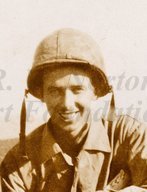
|

|
|
|
|
He was born "in a house out in the country" near Plain Dealing, Louisiana. One of his earliest memories was of the doctor coming to their home to deliver his younger brother. Roger and his brother, Allen Lamar Matlock, were the sons of Alton Matlock and Nannie Lee Matlock. The family was poor during the Depression, he recalls. "We were ashamed to go to town a lot because we didn't have proper clothes and shoes to wear. I could feel that in school, too, in the first, second, and third grades. The clothes I had to wear and going barefoot to school when it was warm. I just felt odd about that." He often wore shirts made from flour sacks. The family raised much of its own food on its forty-acre farm, where they grew cotton and ribbon cane. They also killed hogs and preserved the meat with salt and smoke in an eight-by-eight-foot smokehouse. Living without electricity, the Matlocks lit the home at night with kerosene lamps as well as an Aladdin lamp, with a wick that burned brightly. They owned a battery-powered radio but usually listened only to The Grand Ole Opry on Saturday nights. On Sundays they attended morning and night services at a nearby Methodist church. For transportation, Roger says, "you'd go in the wagon or you'd walk," Roger recalls. During World War II his father began working as a painter for the Bossier Parish School Board. At the same time, his mother was employed in the cafeteria at the Plain Dealing High School, where Roger graduated in 1948. Two days later he hitchhiked to Springhill, Louisiana, and was hired at International Paper Company, where he worked until August 1, 1951. Receiving his draft notice he reported to Fort Humbug in Shreveport. While most of the recruits that day went into the U.S. Army, he was placed in the U.S. Marine Corps. "God was with me," he says. "The best thing that ever happened to me was for me to get in the Marine Corps." Roger took boot camp at Camp Pendleton in San Diego, California. "I have never been through anything as rough as that in my life," he says of the training. Granted leave at Christmas, he came home and married Audrey Atkins on December 22, 1951. (They would have two children and four grandchildren.) Returning to Camp Pendleton, he boarded a troop ship, USNS William Weigal (T-AP-119), bound for Korea. During the voyage, he recalls, he was startled to see Thomas Rogers, a high school friend. Upon landing in Korea, he was sent to the Main Line of Resistance, near the demilitarized zone, as a replacement in Company D, 2nd Battalion, 1st Marine Division. "I was always scared but I was really scared then," he recalls of his military service, then of combat. "It was an experience you'll never forget, really. The war had slowed down some but they were still firing artillery, big guns. Then they had Chinese and Koreans that would probe our lines at night and they would throw mortars in toward us." He saw one piece of shrapnel from a mortar that read, MADE IN THE USA. "They could use our ammunition, but we could not use theirs," he relates. Once, a mortar slammed into a bunker beside one where he slept. "The good Lord was with us and took care of us," he recalls. When not on the front line he ate well, enjoying ham, steaks, and other treats such as canned chicken his mother sent. Much of the combat he saw was short firefights. He was once nearly killed in a friendly fire incident when a tank fired on his position. While on a seventeen-man patrol on August 7, 1952, the Chinese sprang an ambush. Shrapnel from a grenade tossed behind him entered his right foot and the calf of his left leg. "It really didn't hurt; it felt like a sting inside," he says. "I still kept firing my weapon." The patrol moved into another position, where he was hit again in his right arm. "It felt just like a big wasp had stung you," he says. Two died and seven were wounded in that firefight. He remembers gratefully a black soldier from Mansfield helping him onto a stretcher and giving him his own bulletproof vest to protect him. Roger was placed on a helicopter and flown to a Mobile Army Surgical Hospital (MASH) unit. "It was a field hospital, just exactly like you see on the television program, M*A*S*H," he recalls. After a few days he was put on a troop train and sent to a hospital ship, USS Haven (AH-12) where he enjoyed "clean sheets and cold sweet milk to drink" while recuperating for about a week. Roger later recovered in stateside hospitals in Mare Island, California, then in Millington, Tennessee, where he remained four months until his discharge. He returned to International Paper Company, where he worked until his retirement in 1985. He continued to do consulting work for the company. "I guess what changed me the most is by being in combat, being in the Marine Corps, having the discipline," says this American Legion member. "It made me prouder of this country. It made me proud to be an American." |


